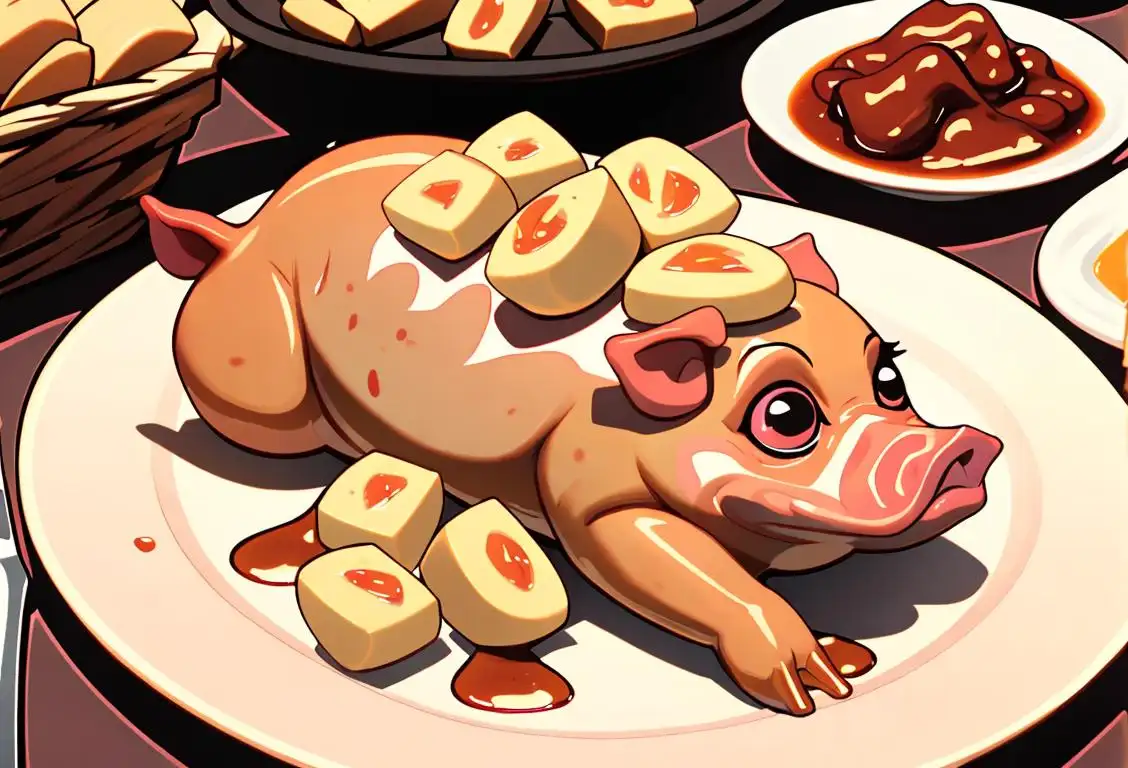National Roast Suckling Pig Day

Welcome to the sizzling world of National Roast Suckling Pig Day! Get ready to feast your eyes (and your taste buds) on this pork-tastic extravaganza. Whether you're a food enthusiast, a BBQ lover, or just someone who appreciates a good ol' roast, this special day is sure to leave you wanting more. So grab your carving knife, put on your bib, and let's dive into the delicious history of National Roast Suckling Pig Day!
When is Roast Suckling Pig Day?
It's national roast suckling pig day on the 18th December.
A Feast Fit for a Pig
National Roast Suckling Pig Day is a celebration of one of the most succulent and flavorful dishes known to man - the roast suckling pig. This mouthwatering delicacy consists of a young piglet that is typically roasted until it reaches a golden brown hue, resulting in tender meat that practically melts in your mouth.
While the origins of this delectable day remain a mystery, the tradition of roast suckling pig can be traced back centuries. It is believed that this culinary creation originated in ancient China, where it was considered a symbol of wealth and prosperity. Over time, it spread to other parts of the world, becoming a beloved dish in countries like Spain, Portugal, and the Philippines.
A Culinary Adventure
Preparing a roast suckling pig is no small feat. It requires skill, patience, and of course, a few secret ingredients. The piglet is typically seasoned with a blend of herbs and spices, then slow-roasted over an open fire or in a special oven. The result is a crispy skin that crackles with every bite, revealing succulent and juicy meat underneath.
Roast suckling pig is often served as the centerpiece of a celebratory meal, whether it's a holiday gathering, a wedding feast, or a special occasion. It's a dish that brings people together, igniting conversation and creating memories that last a lifetime.
A Day to Indulge
On National Roast Suckling Pig Day, food enthusiasts and BBQ aficionados alike come together to celebrate the art of roasting a pig to perfection. It's a day to indulge in the flavors of this traditional dish, sharing laughter and good times with loved ones.
So, whether you're hosting a pig roast in your backyard or simply enjoying a plate of mouthwatering roast suckling pig at your favorite restaurant, take a moment to savor the rich history and deliciousness that this day has to offer. Happy National Roast Suckling Pig Day!
History behind the term 'Roast Suckling Pig'
1100s
The Early Roasting Tradition
The origins of roast suckling pig trace back to the 1100s when it became a popular dish in medieval Europe, particularly in Spain and Portugal. Roasting pigs whole, and specifically young pigs still being fed on their mother's milk, was a culinary tradition rooted in the Roman and Hebrew cultures.
1546
Birth of a Culinary Delicacy
Roast suckling pig, also known as cochinillo or lechón, has a history that dates back to 1546. The term refers to a young pig that has been weaned from its mother and is still fed on its mother's milk. This tender and succulent delicacy gained popularity in Spain and Portugal, where it became a traditional centerpiece for festive occasions and special celebrations.
13th century
Roasting of Whole Animals
During the 13th century, roasting whole animals became a popular cooking method in Europe. Feasts featuring large roasted animals were common, and one of the most prized dishes was a roast suckling pig. This delicacy was considered a sign of wealth and prosperity.
15th century
The Birth of Roast Suckling Pig
In the 15th century, the term 'roast suckling pig' emerged as a culinary concept. The idea of cooking whole young pigs had been practiced in various cultures for centuries, but it was during this time that the term became associated with a specific dish. Roast suckling pig involves roasting a young pig, typically between two to six weeks old, until its skin turns crispy and golden while the meat remains tender and succulent.
Roman Times (1st century BC - 5th century AD)
Origins of Roasting Meat
Roasting meat was popular among the Romans, who used an open fire to cook a variety of meats. The practice of roasting a suckling pig, or young piglet, became a delicacy during this time. The Romans considered the flavor and tenderness of the suckling pig to be superior to that of fully-grown pigs.
Roman Empire (27 BC - 476 AD)
Ancient Origins
In ancient Roman feasts, a whole pig, often a suckling pig, was roasted over an open fire as a centerpiece dish. The Roman Empire popularized the tradition of roasting meat, and pigs were considered a symbol of luxury and abundance.
Ancient Rome (1st century BC)
Introduction to suckling pigs
Suckling pigs, referring to young pigs still fed by their mother's milk, were first introduced to the culinary scene during the time of ancient Rome. The Romans had a fascination with meat, and why not? Suckling pigs were tender, juicy, and had a delicate flavor that was highly sought after. As a result, they quickly became a favorite delicacy among the Roman elite.
Medieval Europe (Middle Ages)
Popularization of roasting
During the Middle Ages, the preparation of roasted meats became more prevalent across Europe. Roasting was a popular cooking method due to its ability to seal in the natural juices and flavors of the meat. Suckling pigs, being small and tender, were ideal for roasting whole. The process of roasting a suckling pig is a spectacle in itself, often involving a special spit and a long cooking time over an open flame.
15th Century
Medieval Feasts
During the Middle Ages, roasting a suckling pig became an integral part of extravagant feasts. These feasts were hosted by nobles and wealthy families to showcase their wealth and social status. The roasted pig was a symbol of decadence and was often presented to important guests as a gesture of hospitality.
Medieval Europe (5th century - 15th century)
Feasting and the Banquet Culture
In medieval Europe, the roast suckling pig gained popularity as part of the feasting culture. Feasting and banquets were important social events, often held by nobility and the wealthy. The presentation of a whole roasted suckling pig became a symbol of grandeur and opulence. It was often the centerpiece of feasts, showcasing the host's wealth and generosity.
1484
First Known Recipe
The first recorded recipe for roast suckling pig appeared in a Spanish cookbook written by Ruperto de Nola in 1484. The recipe detailed the process of preparing and serving a suckling pig, which involved marinating the piglet in a blend of aromatic herbs and spices before roasting it to perfection.
14th century
Medieval Banquets
In the 14th century, medieval banquets gained popularity among the nobility and wealthy members of society. These extravagant feasts often featured a variety of dishes, including the highly esteemed roast suckling pig. The succulent and tender meat of a young pig became a symbol of indulgence and celebration.
Ancient Roman Era
Ancient Predecessors
Though not directly related to the term 'roast suckling pig,' the concept of cooking whole young pigs dates back even further. Ancient Romans were known to roast whole pigs called 'porcellum' or 'porcellus' as part of their feasts. This practice influenced many cultures, including medieval Europe and the eventual development of 'roast suckling pig' as a term.
1710
Roast Suckling Pig Spreading Through Europe
Roast suckling pig started to gain popularity in other European countries during the early 18th century. The dish became highly regarded in France, Italy, and England, making its way onto the tables of the aristocracy. Its delectable taste and visually striking presentation made it a symbol of wealth and luxury.
China, 14th - 16th Century
Cantonese Cuisine
In ancient China, specifically during the Ming Dynasty (14th-16th century), there was a popular dish called 'shāo wèi' which involved roasting a whole suckling pig. This dish, still widely popular in Cantonese cuisine today, is prepared by marinating the pig in a flavorful mixture and roasting it until the skin becomes crispy.
1700s
Roast Pig as a Symbolic Dish
Throughout the 1700s, roast suckling pig gained popularity as a festive dish and came to symbolize wealth, celebration, and abundance. In many European cultures, including England and Germany, it became a centerpiece at grand feasts and special occasions, such as weddings and Christmas.
Chinese Culinary Traditions (Song Dynasty, 960-1279)
Suckling Pig in Chinese Cuisine
During the Song Dynasty, roast suckling pig became an integral part of Chinese culinary traditions. Chinese chefs developed techniques to ensure a crispy skin and tender meat, making it a highly sought-after dish. The practice of roasting a whole piglet is still prevalent in Chinese cuisine, especially during festive occasions like Lunar New Year celebrations.
Medieval Europe
Banquets Fit for Kings
During the Middle Ages, roast suckling pig became a popular dish in medieval Europe, especially during grand banquets. These banquets were extravagant feasts hosted by nobility and royalty, showcasing the host's wealth and power. Roast suckling pig was often the centerpiece of these lavish spreads, symbolizing opulence and indulgence.
17th century England
The Hog Roast tradition
In 17th century England, the tradition of roasting a whole pig, especially at festive occasions, was firmly established. This tradition, known as the Hog Roast, involved a pig being slowly roasted on a spit over an open fire for several hours. The communal feast created a lively and convivial atmosphere, bringing people together to enjoy the succulent meat and celebrate special occasions.
16th century
Roast Pig at Royal Courts
By the 16th century, roast suckling pig had made its way into the royal courts of Europe. It was a favorite dish of kings and queens who wanted to showcase their wealth and power. The tradition of serving roast pig at royal banquets continued for centuries, setting a precedent for sophisticated dining and culinary grandeur.
1824
Roast Suckling Pig in American Cuisine
Roast suckling pig soon crossed the Atlantic and made its way into American cuisine. In the early 19th century, this culinary delight became a popular choice for elaborate feasts and special events. The indulgent nature of roast suckling pig perfectly suited the extravagant and lavish dining culture that was prevalent in the United States at the time.
19th Century
The Delectable Tradition Spreads
By the 19th century, roast suckling pig had become a cherished tradition in many parts of the world. It was commonly enjoyed during festive occasions, such as Christmas, Easter, and weddings. Its unique flavor, crispy skin, and tender meat made it a delicacy, earning it a place on the menus of fine dining establishments and inspiring home cooks to master the art of preparing this sumptuous dish.
1933
The La Caja China Invention
In 1933, a Cuban exile named Roberto Guerra invented a unique roasting box known as 'La Caja China.' This wooden box featured a slatted top where the pig was placed, and it utilized indirect heat to roast the pig to perfection. The invention of La Caja China simplified the process of cooking roast suckling pig.
Chinese cuisine (various periods)
Asian influence on roast suckling pig
While the roast suckling pig has its roots in Western cuisine, it is worth noting the significant influence of Chinese cuisine on its preparation. Chinese culinary traditions also embrace the indulgence of suckling pig, with the dish being a highlight of festive banquets and special celebrations. In Chinese cuisine, the roast suckling pig is often enjoyed with a crispy skin and tender meat, showcasing the skillful techniques of Chinese chefs.
Colonial America (17th century)
Roast Suckling Pig as a Symbol of Prosperity
In colonial America, roast suckling pig became a symbol of prosperity and abundance. It was often served as the centerpiece at special occasions, such as Thanksgiving feasts, weddings, and celebrations. The tradition of roasting a whole piglet continued to be passed down through generations, symbolizing bounty and good fortune.
20th Century
Roast Suckling Pig Goes Global
With the advancements in transportation and globalization during the 20th century, roast suckling pig found its way into various culinary traditions around the world. It became a cherished dish in many countries across Europe, Asia, and Latin America, adapting to local flavors and cooking techniques. Today, this succulent delicacy continues to captivate food enthusiasts worldwide.
19th century
The Pig as a Centrepiece
During the 19th century, the roast suckling pig became a popular centrepiece for special occasions and festive gatherings. The presentation of a whole pig, with its crispy skin and succulent meat, became a spectacle that delighted both the eyes and the taste buds. It symbolized abundance, family reunions, and the joys of shared meals.
18th Century
European Colonization
With European colonization, the tradition of roasting suckling pig spread to various parts of the world. In Europe, especially in Spain and Portugal, roast suckling pig, known as 'lechón' and 'leitão' respectively, became a celebrated dish in festive occasions and religious festivals.
Present Day
Continued Popularity
Roast suckling pig has maintained its cultural significance and popularity throughout the years. It is still commonly served during festive events, weddings, and special occasions in many parts of the world, including Spain, Portugal, China, and various Latin American countries. The dish continues to be cherished for its succulent and flavorful meat, as well as its visually impressive presentation.
Modern Times
Continued Culinary Tradition
Roast suckling pig continues to be a celebrated dish in many cultures around the world. It has become a staple at festive events such as weddings, holidays, and cultural ceremonies. Despite changes in culinary preferences, the allure of a beautifully roasted pig remains, showcasing the rich history and cultural significance of this traditional dish.
Modern times
Roast suckling pig as a gourmet dish
In modern times, roast suckling pig has retained its status as a lavish and gourmet dish. It is often served as the main attraction at special events, such as weddings, family gatherings, and festive celebrations. The crispy skin, delicate flavor, and succulent meat continue to captivate food enthusiasts around the world, making roast suckling pig a true culinary masterpiece.
Modern Cuisine (20th century - present)
Roast Suckling Pig Across Cultures
Roast suckling pig remains a popular and coveted dish in modern cuisine, enjoyed by people from various cultures around the world. It is featured in traditional recipes and festive celebrations in countries such as Spain, the Philippines, Puerto Rico, and many others. The art of perfectly roasting a suckling pig continues to be cherished, capturing the attention and taste buds of food enthusiasts globally.
21st Century
Global Culinary Delicacy
Roast suckling pig has transcended its European origins and has become a global culinary delicacy. It is highly regarded in various cuisines and cultures around the world. In Chinese cuisine, roasted suckling pig is a signature dish, and in the Philippines, it is a popular centerpiece during festive occasions like holidays and important family gatherings.
Present Day
Continued Culinary Delight
Today, roast suckling pig continues to be celebrated as a culinary delight in many cultures. It has become a staple of traditional festivals, family gatherings, and special occasions, showcasing the rich heritage and culinary prowess of different regions around the world. Whether enjoyed as part of a grand feast or relished in a cozy family setting, roast suckling pig remains a symbol of indulgence and celebration.
Did you know?
Did you know that the crispy skin of a roast suckling pig is often considered the best part? It's a pork crackling extravaganza!Tagged
food loved onesFirst identified
18th December 2015Most mentioned on
18th December 2016Total mentions
206Other days
Biscuit Day
Cheese Lovers Day
Cheese Pizza Day
Agriculture Day
Bacon Day
Medal Of Honor Day
Pumpkin Day
Foundation Day
Guac Day
Drink A Beer Day









